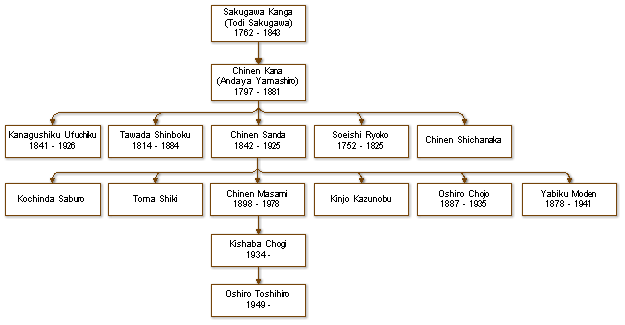


Yamanni Chinen Ryu Kobujutsu
An Introduction to Yamanni Chinen-Ryu bojutsu
By Martin Nobida
About...
Yamanni Chinen-ryu kobujutsu, or Yamanni-ryu, is a traditional weapons martial art that originated in Okinawa. The principle weapon used in the style is the roku-shaku bo, or six-foot staff. The style has been described as one of the most dynamic and devastating of the Okinawan weapons styles, most probably because of its distinctive wide and flowing strikes, which contrast greatly with the short and choppier movements characteristic of other weapons styles that trace their roots to Okinawa.
History
Many of the major modern Okinawan-based bojutsu styles have their roots in Yamanni-ryu, with their founders getting at least some training with Yamanni-ryu masters. As such, many kata, or prearranged fighting sets, of various styles share the same names as Yamanni-ryu kata. And though their sequences are similar, the individual techniques and body dynamics are very different and, arguably, much less sophisticated. Unlike other modern Okinawan kobudo styles, which have become mainstream as a result of successful efforts to propagate them, Yamanni-ryu had remained relatively secretive and guarded. Recently, however, through the efforts of the current grandmaster, Chogi Kishaba, and his premiere student, Toshihiro Oshiro, the style has been gaining widespread exposure around the world. In recent times, other traditional Okinawan weapons, such as the sai, tonfa, kama, and nunchaku have been incorporated into the system; the philosophy for manipulating these weapons is very similar to that used for the bo--namely, techniques should almost always be large and flowing.
Roots
Yamanni Chinen-ryu takes its name from the Chinen family, which was a prominent aristocratic family in the Ryukyu islands. According to many historians, the legendary martial artist "To-de" Sakugawa brought a staff-fighting art from China to Okinawa sometime in the late 1700s. The Chinen family, which was entrusted with the security of Ryukyu nobles, adopted and further developed this art over the course of a few generations. As such, this style of bojutsu is not a product of the peasant classes. Like most martial arts of the time, the techniques were passed on mainly within the family. Legend has it that Sanda Chinen, the grandmaster of the style, dreamt of a bouncing bo one day. This gave him inspiration for developing bo swings that rapidly recover into kamae or continue on in a rapid succession of strikes, for which Yamanni-ryu is so well-known today. Kishaba-sensei trained under Sanda Chinen’s grandson Masami Chinen. His principle students include Oshiro Toshihiro and Shinzato Katsuhiko whom he taught privately throughout the ’70s. In 1992, Kishaba-sensei opened a small dojo in Naha, Okinawa, and there has been teaching small classes of students for the very first time. In the United States, Oshiro-sensei, as the leading authority of the style outside of Japan, is "under orders" from Kishaba-sensei to propagate the art around the world. In addition to running a successful dojo near San Francisco, where students from all styles have come to benefit from his knowledge and experience, he has conducted numerous demonstrations and seminars around the United States, and is in demand in Japan, Germany, France, Panama, and elsewhere. Oshiro-sensei has also released a Yamanni-ryu video, which is available from Tsunami Video.
Genealogy

Katas
Kata included in the Yamanni-ryu bojutsu system include the following:
Bojutsu
... Donyukon ichi (Initiation)
... Donyukon ni (Initiation)
... Choun no kun sho (Basic)
... Choun no kun dai (Basic)
... Ryubi no kun (Intermediate)
Traditional
... Shuji no kun (Intermediate)
... Sakugawa no kun (Intermediate)
... Shirataru no kun (Advanced)
... Tomari Shirataru no kun (Advanced)
... Yunigawa / Yonegawa no kun / Hidari bo (Advanced)
... Shinakachi / Sunakake (Advanced)
... Chikin bo / Tsuken bo (Advanced)
Source: http://www.oshirodojo.com




